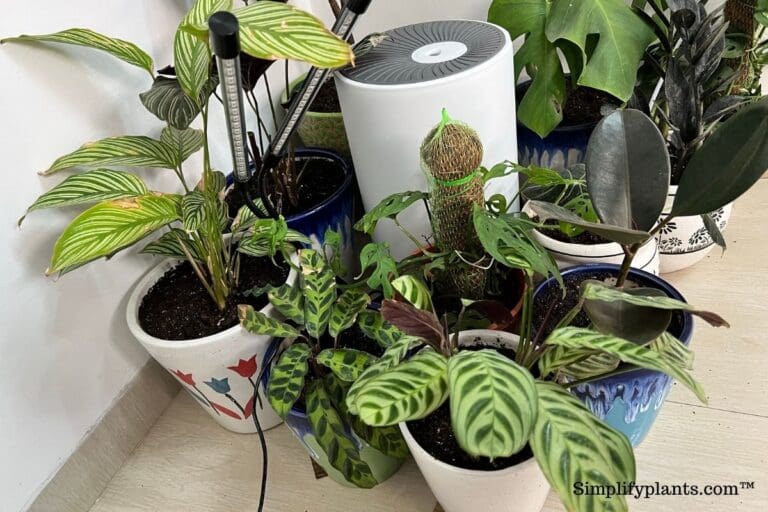9 Reasons Why Your Peace Lily Leaves Are Curling!
Peace lilies (Spathiphyllum sp.) are a stunning addition to the collection of indoor plants for any home. Their attractive dark green foliage with unusual calla-like white flowers add a different angle of delicacy. The exceptionally vibrant green leaves are a beauty quotient for peace lilies, and it is pretty frustrating to see them curled.
The intensity of the light, temperature fluctuations, inadequate watering process, low humidity, and diseases are primary reasons behind the curling of peace lilies. Move the plant to a bright spot, maintain the correct humidity levels and water them adequately to fix curly leaves in peace lilies.
Let’s find out in detail about the factors responsible for leaf-curling and the adjustments needed to be done to regain your plant’s health.

Please note: Simplify Plants is reader-supported. Some links in the post are affiliate links and I get a commission from purchases made through links in the post.
Why are peace lily leaves curling?
We will discuss the reasons behind the curling leaves on the peace lily plant and how you can fix them.
Direct sunlight
Peace lilies thrive in the tropical forest floor under the dense canopy of tall trees in their natural habitat, where they receive dappled sunlight. Therefore keeping your peace lily under direct sunlight can be harmful to this species.
Too much sunlight for a prolonged period can cause leaf distortion by oxidizing the photosynthetic pigment – chlorophyll. It can even make the leaves turn brown due to sunburn.
If you observe your peace lily’s leaves curling up, primarily examine if it is getting excess sunlight.
Solution
The good news is that treating your plant from the effect of excess sunlight is not so hard.
- Move your peace lily to a shadier area of your home.
- Don’t keep the plant on an open windowpane. Keep it a few feet away from the window to allow it to absorb indirect sunlight.
- West and south-facing rooms generally receive bright indirect light. Try to keep your plant in one of those rooms, adjusting a minimum distance from the windowpane.
- The duration and intensity of light vary from season to season. For instance, if you keep your plant in front of a west-facing window during summer, you need to move it to a south-facing area during winter to allow adequate light.
- If adjusting the position of the plant seems a bit tricky, you can even provide shade and infused light to your favorite peace lily by hanging some semi-transparent curtain on the window pane.
Also read: What Kind Of Light Does A Peace Lily Need? (Peace Lily Light Requirements)
Temperature stress
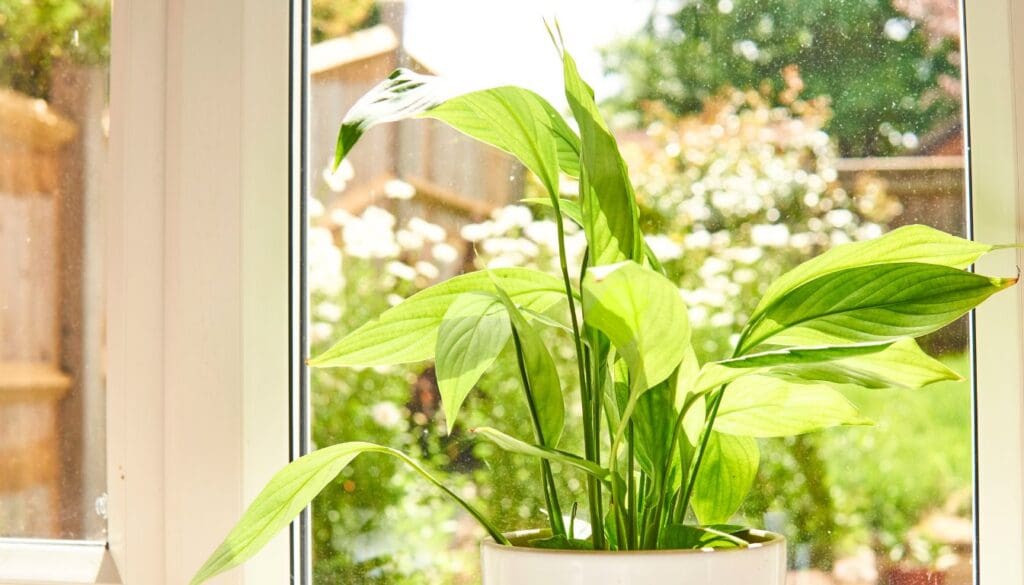
Temperature stress can also be a cause behind curling leaves on the peace lily. These species prefer uniform temperature without much fluctuation.
They mostly thrive well on average to warm room temperatures of approximately 75°F during the day and temperatures about 10°F cooler at night.
Sudden temperature changes, especially an uprise in temperature, will alter its physiological function, putting unnecessary stress on the plant.
High temperature increases the rate of transpiration, which means a relative increase in water loss, leaving the leaves curled up due to water deficiency.
Solution
Just like light issues, temperature management is not that complex. You can solve this problem with some easy solutions.
- Keep your peace lily in a room where the temperature does not fall below 45°F and does not rise above 90°F.
- To see the leaves perk up, move your plant to a cooler room.
- Do not keep your plant near any heating equipment like a heater, oven, etc.
- Peace lilies can tolerate a slight drop in temperature, but extremely low temperatures below 45°F can cause harm to the plant.
- During winter, try to keep the plant in a well-insulated room.
- Never keep the plant on an open windowpane during winter to keep it away from cold drafts of wind.
Also read: Where Should Peace Lily Be Placed? (Ideal Spot+Placement Tips)
Low humidity
Being a tropical species, peace lilies prefer high humidity, just like their native environment in the wild. The ideal humidity for these species is 60% or more, though they can withstand a minor fluctuation in that range.
Excessive lowering in relative humidity will increase the rate of transpiration, leading to excess water loss from the plant’s body.
Water will be pulled out from the leaves, and the leaves will curl up to retain moisture from the dry wind to cope with this deficiency.
Thankfully there is a range of solutions to this problem.
Solution

Some of the popular solutions are:
Misting
- Misting your plant can be helpful in this case as it models their natural environment by adding humidity.
- Spray your plant (with filtered water) depending on the environmental moisture level. Some plant owners may need to mist more if they are staying in a drier area.
Keep the peace lily in high humidity rooms.
- You can keep your peace lily in a well-lit bathroom or near a pool area as these places are generally high in humidity.
Create humidity for the plant.
- Misting is required more during dry winter months. You can install a budget-friendly humidifier to maintain a constant moisture level.
- You can use a pebble tray to enhance the humidity level by placing your plant pot on it for some time and allow it to rest and absorb the water from the pebble tray.
- Group your plants during winter time to help them exchange moisture through transpiration.
Also read: Do Peace Lilies Need Misting? (+Ideal Humidity)
Underwatering or overwatering
A consistent watering schedule is a crucial element to having a healthy plant.
A plant that is overwatered or thirsty will show significant signs of stress. The earliest signs will appear on the leaves as curling of the leaf blade.
Also read: How Often Should A Peace Lily Be Watered? (Peace Lily Water Requirements)
Solution
A clear idea of when to water and when to not is the ultimate solution to this issue.
A general rule of thumb is that peace lilies need to be watered once a week. But the watering frequency of the plant changes depending upon the season, plant age, temperature, etc.
Try these essential tips to have a correct watering schedule:
- Insert your finger about 2-4 inches into the soil.
- Water the soil thoroughly if it feels dry.
- Do not apply water if it feels damp.
- Peace lilies need more water during summer and spring. Reduce the rate of watering during winter.
- You can apply the capillary method to avoid overwatering. At first, spray the soil till it is moist enough, then apply a ½-1 cup of water, depending on the soil mix quantity, to the soil. The already moist soil will allow easy and uniform distribution of water throughout the soil.
- Keep a check whether the soil appears crumbled to avoid underwatering.
Also read: How To Save An Overwatered Peace Lily? (Signs, Problems & Solution)
Improper fertilizer application
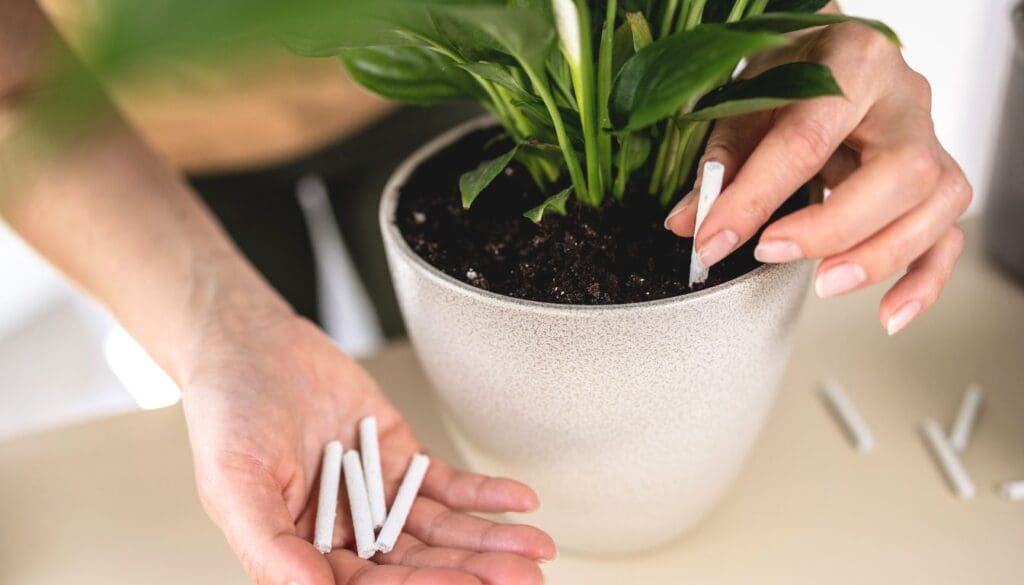
Although peace lilies are not heavy feeders, they need fertilizers every two or three months to meet the nutrient needs during their actively growing season, from spring to fall.
A lot or very little fertilizer can affect the leaves, causing them to curl.
If you have over or under-fertilized your plant, try to follow the steps.
Solution
- If you have skipped fertilization for an extended period and your plant has started to show its sign, you need to apply a diluted solution of general-purpose fertilizer for indoor plants more frequently.
- Go for 20:20:20 NPK (Nitrogen, Phosphorous, and Potassium) mix.
- Apply liquid fertilizers following the recommended dosage to enhance rapid absorption by the plant.
- If your peace lily is suffering due to over-fertilization, you need to repot it to avoid further deterioration in its health.
- Carefully pull the peace lily out of the pot, remove the soil and wash the roots. Let the roots dry for some time and then repot it with fresh soil mix as it needs to be placed in soil that is not too high in nutrient content.
- Do not fertilize the plant for about 1-2 months after repotting as the plant needs to stabilize its growth in the new environment.
- Never apply fertilizers to the leaves.
- Reduce the fertilization rate during winter as their nutrient need decreases remarkably during that time, and an excess of it will cause the burning of leaves.
Also read: What Kind Of Fertilizer Does A Peace Lily Need? (Peace Lily Fertilizer Ratio)
Quality of water
Choosing the right water quality is another crucial factor in maintaining the plants’ health. Using poor quality water or water with harmful chemicals like chloride, fluoride, lead can harm the plant and cause leaf curling.
Tap water contains many minerals, which can put an excessive load over the plant, causing stress.
Solution
Use filtered water for watering your plant. Just like other organisms, plants thrive well by getting the correct quantity and quality of water.
Pest infestation
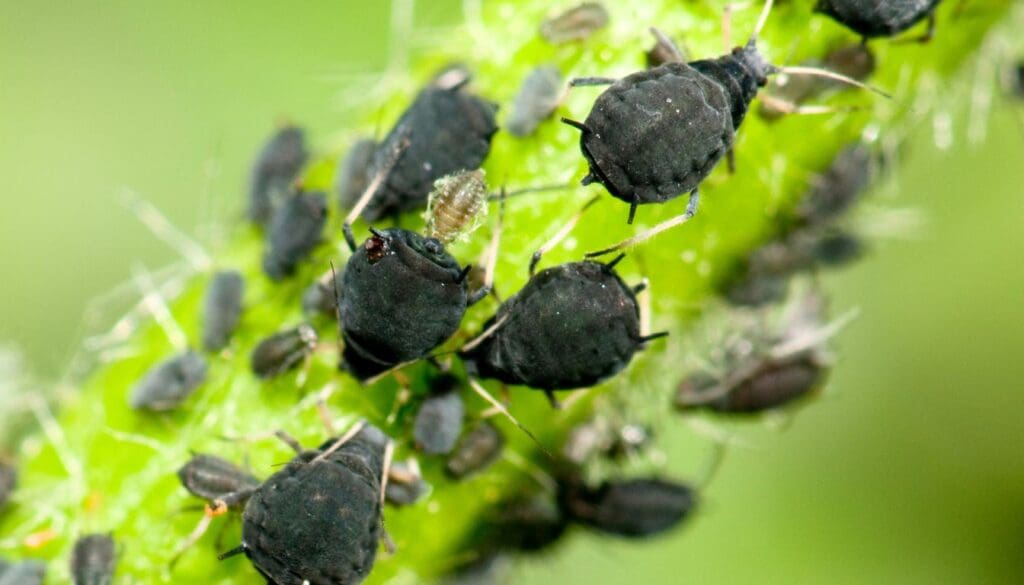
Poor air circulation, dust and dirt, dehydration, and even excess moisture make an ideal environment for pests. Some common pests that cause harm to peace lily are:
Whitefly: This white color insect is found at the base of the leaf. They feed on the nutrients on the leaves and excrete a sugary substance that eventually covers the leaf and prevents it from light absorption.
Mealybugs: Mealybugs attach their egg sacs to the leaves and suck sap from the leaves.
Aphids: Palm aphids suck juices from the leaves and stems of peace lily, leaving them lifeless and curled.
Spider mite: These tiny bugs make webbings on the leaf and make them look discolored.
You can easily treat a light infestation of these pests, but a severe infection is generally hard to treat.
Solution
- The most common treatment includes spraying light soapy water on the pests and even on the plants. Make sure not to use any scented soap, detergent, or dishwasher.
- You can also apply 1 teaspoon of neem oil diluted in 1 cup of water on the plant through a spraying medium.
- Put some yellow sticky traps at the base of the plant, and the insects will flock to the paper.
- Dusting your plant with a wet cloth will discourage any pest infestation. Maintain a weekly cleaning schedule.
Also read: Do Peace Lily Attract Bugs? (Identification+How ToGet Rid Of Them)
Root rot
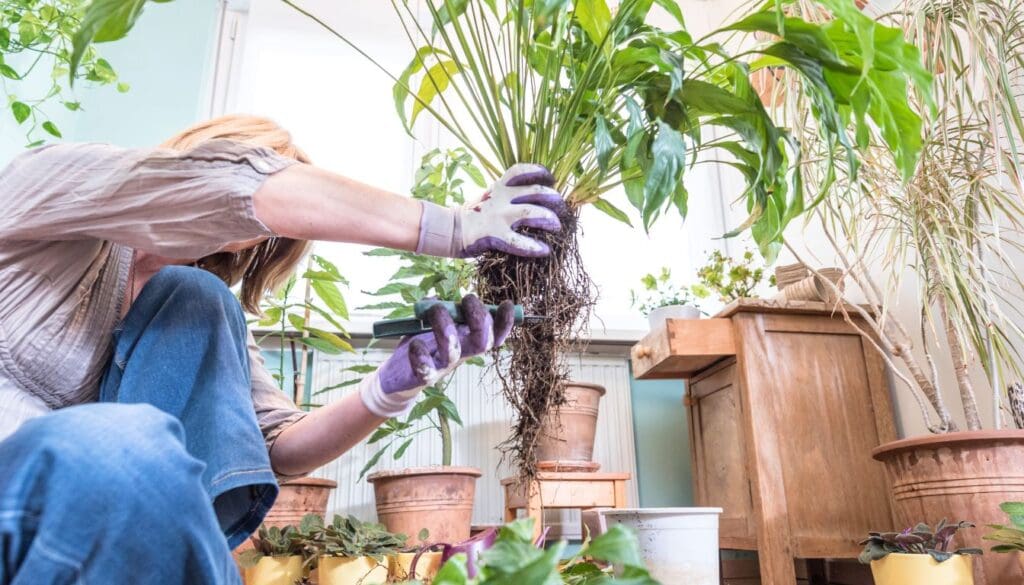
Root rot is a severe disease that affects your peace lily badly. It is mainly caused due to overwatering that leads to damp, waterlogged soil. Such soil supports pest infestation, infecting the root system.
Solution
Worrying too much will complicate the situation.
- Check for the other factors like light, temperature, watering procedure and maintain the correct limit of these factors that can cause root rot.
- Take out the plant from the pot, check for any decaying roots.
- Cut off the affected roots with sterilized equipment.
- Repot your peace lily in a fresh soil mix to avoid further contamination.
Also read: How To Treat Root Rot In Peace Lily? (Signs, Identification & More)
Overcrowded pot
If you have already checked the factors mentioned above and tried most problem-solving strategies yet didn’t get any good results, this final point might help you.
Peace lilies love to remain pot bound, i.e., the roots remain well spread, occupying most of the space in the pot.
But over time, with consistent growth, the plant may feel the need for a bigger pot. Keeping your plant in a smaller pot with a limited nutrient source will restrict its growth and cause the leaves to curl.
Solution
- The best and only possible solution is repotting the plant in a bigger pot.
- Use a fresh soil mix that is peat-based and has perlite-gravels for better permeability.
- Never grow a peace lily in a pot that is wider than 10 inches.
- If your plant is too big, divide it into two and pot it separately. Thus you will get a new plant to decorate a corner of your house.
Also read: Do Peace Lilies Like To Be Root Bound? (+When To Repot)
How to prevent curling leaves on your peace lily?
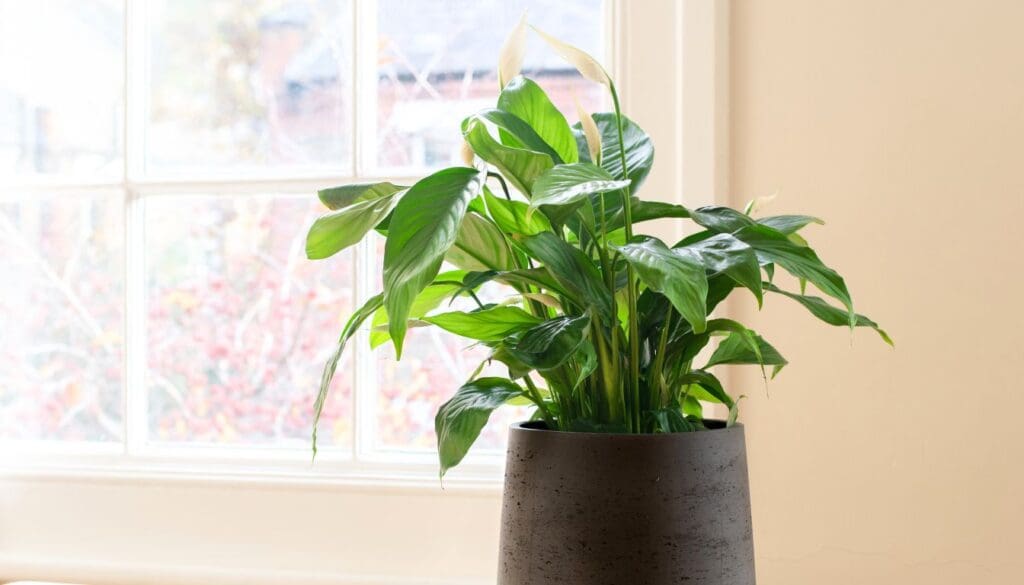
Now you know the potential causes behind leaf curling and their solutions, but still, you need to maintain healthy growth for your plant to avoid any such consequences.
But how? We will assist you with it.
- Scan the room properly to check the exact amount of light and the absence of any component before placing your plant.
- Track the temperature.
- Check the soil regularly to be oversure with the watering schedule.
- Keep track of fertilization.
- Discard or keep away any infected plant from the others.
- Trace the watering frequency. Many ask for the signs of overwatering. Generally overwatered peace lilies will end up having widespread yellow foliage, brown tips on leaves, drooping leaves, mushy roots, leaf spot disease.
Don’t give up! If you witness a problem that stays for long, have patience. Indoor plants, specifically peace lilies, are hardy.
Limiting some factors and enhancing some generally work efficiently in regaining their strength. With a bit of troubleshooting, your favorite peace lily leaves will perk up soon.
Ref: ScienceDirect, NCBI, University of Vermont, Nationalgeographic, NC state university, University of Florida, The University of Arkansas, Queensland Government.
Recommended Garden Supplies
| Product Image | Our Recommended Gardening Supplies | Check Offers! |
|---|---|---|
Top Top
Top
Top
Top
Top
Top
Top
Top | rePotme Houseplant and Tropical Classic Potting Soil Mix | Check Offer On Amazon |
 Top
Top
Top
Top
Top
Top
Top
Top | Espoma Organic Indoor Plant Food | Check Offer On Amazon |
 Top
Top
Top
Top
Top
Top
Top
Top | GooingTop LED Grow Light 6000K Full Spectrum Clip Plant Growing Lamp | Check Offer On Amazon |
 Top
Top
Top
Top
Top
Top
Top
Top | Soil Moisture Meter | Check Offer On Amazon |
 Top
Top
Top
Top
Top
Top
Top
Top | Govee Hygrometer Thermometer, Bluetooth Enabled! | Check Offer On Amazon |
 Top
Top | LEVOIT Humidifiers for Large Room(Best For Plants) | Check Offer On Amazon |
 Top
Top
Top
Top
Top
Top
Top
Top | Upgraded DIY Automatic Drip Irrigation Kit, 15 Potted Houseplants Support | Check Offer On Amazon |
 Top
Top
Top
Top
Top
Top
Top
Top | Stainless Steel Heavy Duty Gardening Tool Set | Check Offer On Amazon |
 Top
Top
Top
Top
Top
Top
Top
Top | Bonide Insecticidal Soap | Check Offer On Amazon |
 Top
Top
Top
Top
Top
Top
Top
Top | Bonide 32 oz Spray Neem Oil for Organic Gardening | Check Offer On Amazon |
 Top
Top
Top
Top
Top
Top
Top
Top | Garden Safe Fungicide | Check Offer On Amazon |





